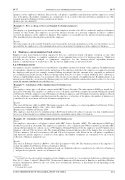Page 659 - SAIT Compendium 2016 Volume2
P. 659
IN 77 Income Tax acT: InTeRPReTaTIon noTes IN 77
purposes of the employer’s business. Based on the cell phone’s capabilities and functions and the employee’s actual use of the phone, the number of minutes are considered to be an accurate re ection of business and private use. The taxable bene t for February 2014 is calculated as follows:
R300 × 50 / 90 = R166,67.
Example 8 – Free or cheap services used mainly for business purposes
Facts:
An employee is granted internet access at home by the employer in order to be able to conduct the employer’s business outside of of ce hours. The employee accesses the internet at home on a personal computer in order to conduct research for purposes of the employer’s business. The employee occasionally uses the internet for private purposes. The monthly internet subscription is paid by the employer.
Result:
No value is placed on the taxable bene t because based on the facts and circumstances of the case the internet access provided by the employer is a telecommunication service used mainly for purposes of the employer’s business.
4.2 Employee-owned equipment and services
Employees may incur business-related expenses if they use a privately-owned cell phone or laptop (or any other privately-owned telephone or computer equipment or telecommunication service) for business purposes.* Employers generallyuseoneoftwo methods to compensate employees for the business-related expenditureincurred, namely, a reimbursement or an allowance. The income tax implications are discussed below.
4.2.1 Reimbursement
An employee may be reimbursed for actual business expenditure incurred on behalf of the employer. Reimbursements of expenditure, which were incurred on the instruction of the employer and where the employee is required to provide the employer with proof (for example, itemised billing statements) that the amounts were expended as instructed, are excluded from taxable income.† Refer to Interpretation Note No. 14 (Issue 3) dated 20 March 2013 ‘Allowances, Advances and Reimbursements’, for an analysis of the income tax treatment of reimbursements. Reimbursements at an amount greater than the cost incurred for business purposes will be included in remuneration and are subject to tax to the extent the amount reimbursed exceeds that cost.
Example 9 – Calculation of the reimbursement for business use
Facts:
An employee enters into a cell phone contract with ABC Service Provider. The subscription is R600 per month for a period of 24 months. The employee is entitled to a free cell phone and 500 free minutes per month. During the month of February 2014 the employee used 150 minutes for business purposes and 300 minutes for private purposes. Based on the cell phone’s capabilities and functions and the employee’s actual use of the phone, the number of minutes are considered to be an accurate re ection of business and private use.
Result:
The total of February’s bill was R600. The business portion of the employee’s actual expenditure for February 2014 is calculated as follows: R600 × 150 / (150 + 300) = R200
Business use = R200 for February 2014
The employee may therefore be reimbursed up to R200 and it will not be subject to income tax. Any reimbursement in excess of this amount is a reimbursement of private expenditure and is subject to taxation.
Example 10 – Calculation of the reimbursement for business use
Facts:
An employee enters into a cell phone contract with ABC Service Provider (ABC). The subscription is R600 per month for a period of 24 months. The employee is entitled to a free cell phone and 500 free minutes per month. ABC charges R2 per minute for calls in excess of 500 minutes. During February 2014, the employee used 250 minutes for business calls and 570 for private calls. The itemised billing statement indicates that of the minutes that exceeded the 500 free minutes, 210 were for business calls and 110 were for private calls. Based on the cell phone’s capabilities and functions and the employee’s actual use of the phone, the number of minutes are considered to be an accurate re ection of business and private use.
Result:
The total of February’s bill was (R600 + (320 × R2) per minute) = R1 240. The business portion of the employee’s actual expenditure for February 2014 is calculated as follows:
• Business portion of the monthly subscription (based on call minutes that are considered to be re ective of business
and private use) plus the actual cost of business calls
* Section 23(m) does not restrict an employee from claiming a section 11(e) wear-and-tear deduction (see Interpretation Note No. 13 (Issue 3) dated 15 March 2011 ‘Deductions: Limitation of Deductions for Employees and Of ce Holders’ for more information). However, the cost of the asset on which the allowance is based may be nil depending on the particular contract.
† Section 8(1)(a)(ii).
saIT comPendIum oF Tax LegIsLaTIon VoLume 2 651


